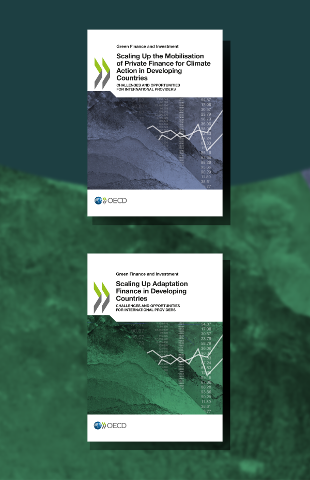At the 15th Conference of Parties (COP15) of the UNFCCC in Copenhagen in 2009, developed countries committed to a collective goal of mobilising USD 100 billion per year by 2020 for climate action in developing countries, in the context of meaningful mitigation actions and transparency on implementation. The goal was formalised at COP16 in Cancun, and at COP21 in Paris, it was reiterated and extended to 2025.
At the request of donor countries, the OECD has been tracking progress towards this goal since 2015. It produces regular analyses of progress made, based on a robust accounting framework that is consistent with the COP24 outcome agreed by all Parties to the Paris Agreement on funding sources and financial instruments.
Released on 16 November 2023 by the OECD Secretary-General, this report presents aggregate trends of annual climate finance provided and mobilised by developed countries for developing countries for the period 2013-21. It includes breakdowns by climate theme, sector, financial instrument and region for the period 2016-21. The report also provides key recommendations for international providers to increase financing for adaptation and more effectively mobilise private finance for climate action, which are both key policy priorities and current bottlenecks. The recommendations in this report draw from two supplementary OECD publications on scaling up private climate finance and adaptation finance.
.png)
Key findings include:
OECD analysis on trends of climate finance provided and mobilised by developed countries for developing countries show that there is a pressing need for international providers to significantly scale up their efforts in two essential areas: adaptation finance and the mobilisation of private finance. Scaling up both adaptation finance and the mobilisation of private finance requires a major reorientation in the scope, composition, and strategic use of international climate finance.
In parallel to its sixth assessment of trends of climate finance provided and mobilised, the OECD has released two special reports, available below, that outline a set of actions and recommendations for international providers to increase finance for adaptation, and to more effectively mobilise private finance for climate action. Relevant to both reports are the following key messages:
Read the report Scaling up the mobilisation of private finance for climate action in developing countries: Challenges and opportunities for international providers.
Read the report Scaling up adaptation finance in developing countries: Challenges and opportunities for international providers.

On Sunday 3 December at 16:15 - 18:45 (GMT+4) the OECD and Canada will co-host an official COP28 Side Event: Scaling up adaptation finance and private finance mobilisation - Actions for international providers, to present recent OECD analysis and discuss opportunities to scale up finance for adaptation and the mobilisation of private finance in the context of the USD 100 billion goal, while contributing to broader climate-resilient and private sector development in developing countries.
This session will take place live from Dubai and will be livestreamed on the OECD COP28 Virtual Pavilion. REGISTER for the livestream.
The event will open with introductory remarks by the OECD Secretary-General Mathias Cormann and Canada’s Ministry of the Environment and Climate Change Steven Guilbeault, followed by a panel discussion with:
- Jennifer Morgan, State Secretary and Special Envoy for International Climate Action of Germany
- Seyni Nafo, Coordinator of the Africa Adaptation Initiative
- Other speakers TBC
Jo Tyndall, OECD Director of Environment, will moderate.
View all upcoming events: OECD COP28 Virtual Pavilion | 23 November - 12 December 2023
OECD figures capture four distinct components of climate finance provided and mobilised by developed countries:
OECD publications relating to the USD 100 billion goal also include less regular forward analyses. The most recent one, released in 2021 ahead of COP26, provided scenarios for the period 2021-2025, based on most recent pledges made by bilateral and multilateral public climate finance providers. It indicates that the USD 100 billion could be met as of 2023.